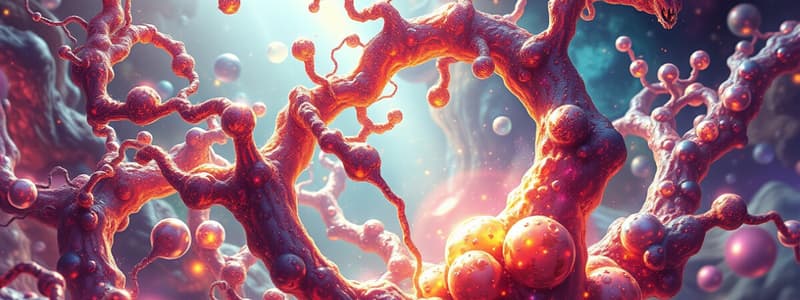Podcast
Questions and Answers
What are enzymes?
What are enzymes?
- They are lipids.
- They are proteins that behave as catalysts. (correct)
- They are nucleic acids.
- They are carbohydrates.
Enzymes work by _____.
Enzymes work by _____.
reducing the energy of activation.
Most enzymes are _____.
Most enzymes are _____.
proteins.
What specific types of energy are present in a candy bar?
What specific types of energy are present in a candy bar?
Why is the statement 'When energy changes forms, some energy is always lost' incorrect?
Why is the statement 'When energy changes forms, some energy is always lost' incorrect?
Entropy is a tendency toward _____.
Entropy is a tendency toward _____.
Which of the following represents an increase in entropy?
Which of the following represents an increase in entropy?
Where does the energy that life uses to combat entropy come from?
Where does the energy that life uses to combat entropy come from?
Which of the following is true about the reaction of ADP and phosphate to form ATP?
Which of the following is true about the reaction of ADP and phosphate to form ATP?
Which of the following reactions could be coupled with the synthesis of ATP from ADP and phosphate?
Which of the following reactions could be coupled with the synthesis of ATP from ADP and phosphate?
What name is given to the reactants in an enzymatically catalyzed reaction?
What name is given to the reactants in an enzymatically catalyzed reaction?
As a result of its involvement in a reaction, an enzyme _____.
As a result of its involvement in a reaction, an enzyme _____.
Why can't amylase digest cellulose?
Why can't amylase digest cellulose?
How is an intermediate best defined?
How is an intermediate best defined?
How do competitive inhibitors stop a chemical reaction?
How do competitive inhibitors stop a chemical reaction?
Why does feedback inhibition occur at the beginning of a metabolic pathway instead of in the middle?
Why does feedback inhibition occur at the beginning of a metabolic pathway instead of in the middle?
Why do most enzymes not work if the temperature is raised too much?
Why do most enzymes not work if the temperature is raised too much?
What is more efficient for E. coli bacteria: using lactose or glucose as an energy source?
What is more efficient for E. coli bacteria: using lactose or glucose as an energy source?
Study Notes
Enzymes
- Enzymes are proteins that act as catalysts, speeding up biochemical reactions.
- They lower the energy of activation, making reactions occur more easily.
- Most enzymes are proteins, serving crucial roles in various biochemical processes.
Energy Types
- Candy bars contain heat energy, chemical energy from bonds (Calories), and potential energy from their position (e.g., on a table).
Thermodynamics
- The second law of thermodynamics indicates energy transforms; however, energy is not destroyed, merely lost as heat.
- The first law of thermodynamics asserts that energy cannot be created or destroyed.
Entropy
- Entropy refers to the tendency for orderly systems to become disordered.
- An increase in entropy can be seen in actions like breaking a glass, which results in more pieces and greater disorder.
Energy Sources for Life
- Most organisms derive energy from the sun, either through photosynthesis or consuming other organisms that have utilized sunlight.
ATP Formation
- The reaction forming ATP from ADP and phosphate is endergonic, requiring energy input.
- The breakdown of ATP into ADP and phosphate is exergonic, releasing energy.
- Coupling ATP synthesis with an exergonic reaction, like sugar breakdown, allows for efficient energy transfer.
Substrates and Enzyme Actions
- Reactants in enzymatically catalyzed reactions are called substrates.
- Enzymes remain unchanged post-reaction, allowing them to be reused.
Enzyme Specificity
- Amylase can digest starch but not cellulose due to differences in the bond structure preventing proper alignment in the enzyme's active site.
- An intermediate is defined as a product from one reaction that will serve as a reactant in another reaction.
Inhibition and Regulation
- Competitive inhibitors block enzymatic reactions by occupying the active site, preventing the substrate from binding.
- Feedback inhibition occurs at the beginning of metabolic pathways to conserve initial substrates and regulate processes.
Enzyme Stability
- Enzymes denature at elevated temperatures or unsuitable pH/salt concentrations, altering their shape and functionality.
- E. coli optimally uses glucose for energy but can use lactose with the enzyme lactase, albeit less efficiently.
Studying That Suits You
Use AI to generate personalized quizzes and flashcards to suit your learning preferences.
Description
Test your understanding of fundamental concepts in biochemistry including enzymes, thermodynamics, and energy types. Explore how these concepts apply to life and the processes that govern energy changes. Ideal for students diving into the intricate details of biological energy systems.



